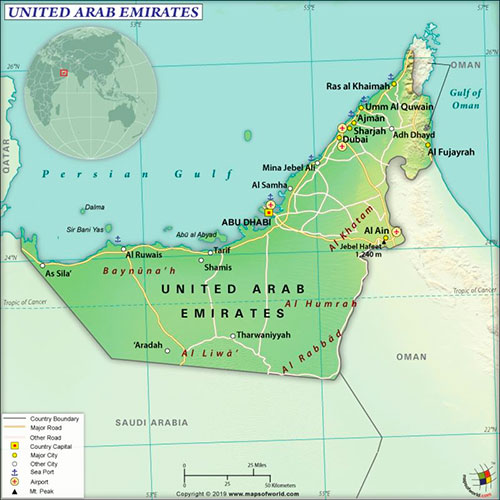
الإمارات.. تاريخ يصنع المستقبل
تعود البدايات الأولى لتاريخ المنطقة إلى عام 6000 قبل الميلاد، حيث كانت مأهولة بجماعات بدوية كانت تعتمد في معيشتها على الصيد والزراعة. كما تميزت تلك الحقبة بصناعة الأواني الفخارية، وفقًا للنتائج التي كشفتها الحفريات الأثرية.
تأسيس دولة الإمارات العربية المتحدة
الإمارات العربية المتحدة دولة اتحادية تأسست في 2 ديسمبر 1971 وتتكون من سبع إمارات هي: أبوظبي، ودبي، والشارقة، وعجمان، وأم القيوين، ورأس الخيمة، والفجيرة.
وتعد دولة الإمارات العربية المتحدة واحدة من الدول الأكثر رسوخاً في التاريخ الحديث، وتتميز بريادتها في مجالات الاقتصاد والاستقرار الاجتماعي والأمني، إذ حافظت على استقرارها على مدى عقود عديدة وسط الاضطرابات التي شهدتها المنطقة.
وتتكوّن سلطات الدولة الاتّحادية من المجلس الأعلى للاتّحاد الذي يضم رئيس الإتّحاد ونائبه + مجلس الوزراء + المجلس الوطني الاتحادي + القضاء الاتحادي.
أوقات العمل الرسمية:
يتبنى القطاع الحكومي الاتحادي في دولة الإمارات نظام عمل يتألف من أربعة أيام ونصف يوم عمل. من الاثنين إلى الخميس والجمعة.
وتكون عطلة نهاية الأسبوع يومي السبت والأحد.
تطبق العديد من جهات العمل نظام الدوام المرن بهدف تعزيز الإنتاجية ورفع مؤشر السعادة لدى العاملين.
التوقيت المحلي: 4+ ساعات حسب توقيت غرينتش

العلم الوطني
ثلاثة خطوط أفقية متساوية ومتوازية هي اللون الأخضر في الأعلى واللون الأبيض في الوسط واللون الأسود في الأسفل، بالإضافة إلى شريط عامودي باللون الأحمر من ناحية السارية.

الموقع
تقع دولة الإمارات العربية المتّحدة في جنوب شرق شبه الجزيرة العربية وتتّخذ خريطتها شكلاً أشبه بالمثلّث حيث تمتد شواطئها من الأطراف الجنوبية والجنوبية الشرقية من الخليج العربي إلى جزء من الشواطئ الغربية لخليج عُمان بما يمنح الدولة موقعاً استراتيجياً عبر المداخل الغربية لمضيق هرمز.
المساحــــة
نحو 82.880 كلم مربّع وتشكّل إمارة أبوظبي ما يعادل %87 من المساحة الكلية للدولة.
وتقدر مسافة سواحل الإمارات بأكثر من 1318 كلم بفضل المشروعات العمرانية المستمرة.
المناخ:
تقع دولة الإمارات العربية المتّحدة في المنطقة المدارية الجافة التي تمتدّ عبر دول آسيا وشمال أفريقيا وتخضع في الوقت نفسه للتأثيرات المناخية المحيطية بالنظر إلى موقعها بمحاذاة ساحلي الخليج العربي وخليج عُمان الذي يتّصل بالبحر الأحمر عن طريق باب المندب.
ويتّصف مناخ دولة الإمارات العربية المتّحدة بالحرارة والرطوبة العالية طوال فصل الصيف، حيث تتراوح درجة الحرارة ما بين 35 و41 درجة مئوية، والرطوبة ما بين 60 و100%. كما يلاحظ عموماً وجود فروق كبيرة بين مناخ المناطق الساحلية والصحراوية الداخلية والمرتفعات في الدولة.
وفي فصل الشتاء، يكون الطقس معتدلاً حيث يتراوح معدل درجة الحرارة ما بين 18 و25 درجة مئوية، وتكون نسبة الرطوبة في أدنى مستوياتها، مع تباين في معدل هطول الأمطار حيث يزداد في سلسلة الجبال الشرقية وهي منطقة تميل بوجه عام إلى البرودة.
السكان:
يتّسم شعب الإمارات بالامتثال للقيم الأخلاقية الرشيدة والتمسّك القوّي بالعادات والتقاليد المتوارثة عبر الأجيال، وفي الوقت نفسه الطموح والتطلّع إلى المستقبل والسعي لبناء بيئة تعانق روح الأصالة والحداثة العصرية معاً. وينعم الإماراتيون بمستوى عيش رفيع المستوى يتمثّل في الحصول على التعليم المتطوّر والخدمات الصحية المتكاملة والرعاية الاجتماعية الشاملة.
وتبذل الحكومة الإماراتية جهوداً جبارةً لتنمية الموارد البشرية المواطنة وتحفيز دور المرأة وتمكينها من تبوّء المناصب المرموقة في المجتمع وسوق العمل.
ووفقاً للمركز الاتحادي للتنافسية والإحصاء، بلغ العدد الإجمالي لسكان دولة الإمارات من مواطنين ومقيمين 9,282,410 نسمة عام 2020.
أحداث تاريخية:
كان البرتغاليون من أوائل الأوروبيين الذين وصلوا لشبه الجزيرة العربية. في عام 1498 م بفضل البحار البرتغالي فاسكو دي غاما.
وسرعان ما سيطر البرتغاليون على تجارة التوابل والفلفل بشكل شبه احتكاري، قبل أن يتراجعوا في القرن السابع عشر، ويواجهون مقاومة من السكان المحليين.
وكانت خسارة البرتغاليين لمضيق هرمز في 1622م بداية لدخول الهولنديين والإنجليز إلى أسواق الشرق الأوسط.
وبحلول عام 1720، نمت الأنشطة التجارية البريطانية في الخليج. وسعى البريطانيون إلى تعزيز قوتهم البحرية لحماية المنافذ التجارية مع الهند.
وفي بداية القرن التاسع عشر، استولى القواسم على السلطة في مسندم، والمناطق الشمالية والشرقية من الخليج العربي بشكل رئيسي ، ما أقلق البريطانيين ليبدأوا الصراع ضدهم.
وبعد استقرار الأمر لبريطانيا، وقعت سلسلة من الاتفاقيات مع مشيخات الخليج بين الفترة من عام 1820 إلى 1853، حافظت على سلامة الطريق البحري، وعززها البريطانيون بمعاهدات لحماية الهدنة البحرية والتي أكسبت المنطقة فيما بعد اسم إمارات الساحل المتصالح.
ومع نهاية القرن التاسع عشر، حصلت بريطانيا على تعهّدات من زعماء الساحل المتصالح لمنح امتيازات النفط في مناطقهم إلى الحكومة البريطانية.
ونتيجة لتلك الاتفاقيات، أصبح من الضروري تعيين ورسم الحدود الداخلية بين إمارات الساحل المتصالح.
وفي بداية عام 1968م، أعلنت بريطانيا عزمها على الانسحاب من منطقة الخليج مع نهاية عام 1971م، وهو ما تحقق بالفعل في 30 نوفمبر 1971م.
أطلق على دولة الإمارات العربيّة المتّحدة قديماً اسم "الغبراء" ومن ثمّ "ساحل عُمان" تيمّناً لاتّصالها بسلطنة عُمان. ويقطن المنطقة قبائل عدّة من أهمها قبيلة بني ياس، وهي قبيلة تنتسب إلى ياس بن عامر، وينحدر من هذه القبيلة آل نهيان حكام أبوظبي وآل مكتوم حكّام دبي، بالإضافة إلى قبيلة القواسم التي تحكم إماراتي رأس الخيمة والشارقة، قبيلة النعيم الحاكمة بعجمان، وقبيلة الشرقي بالفجيرة، وقبيلة آل علي التي ينتسب إليها حكام أم القيوين.
انعقاد لقاء السمحة
صدور الدستور المؤقّت لدولة الإمارات
الإعلان عن قيام دولة الإمارات العربية المتّحدة وانتخاب المغفور له بإذن الله الشيخ زايد بن سلطان آل نهيان "طيب الله ثراه"، حاكم إمارة أبوظبي، رئيساً للدولة والمغفور له بإذن الله الشيخ راشد بن سعيد آل مكتوم "طيب الله ثراه"، حاكم دبي، نائباً لرئيس الدولة وتعيين المغفور له بإذن الله الشيخ مكتوم بن راشد بن سعيد آل مكتوم "طيب الله ثراه" رئيساُ لمجلس الوزراء.
انضمام الإمارات إلى جامعة الدول العربية.
إرسال إمارة رأس الخيمة رسالة إلى المجلس الأعلى لدولة الإمارات تطلب فيها الانضمام للاتحاد.
تأسيس المجلس الوطني الاتحادي.
انعقاد أول جلسة للمجلس الوطني الاتحادي.
استضافة الإمارات لأوّل مرّة قمة خليجية.

